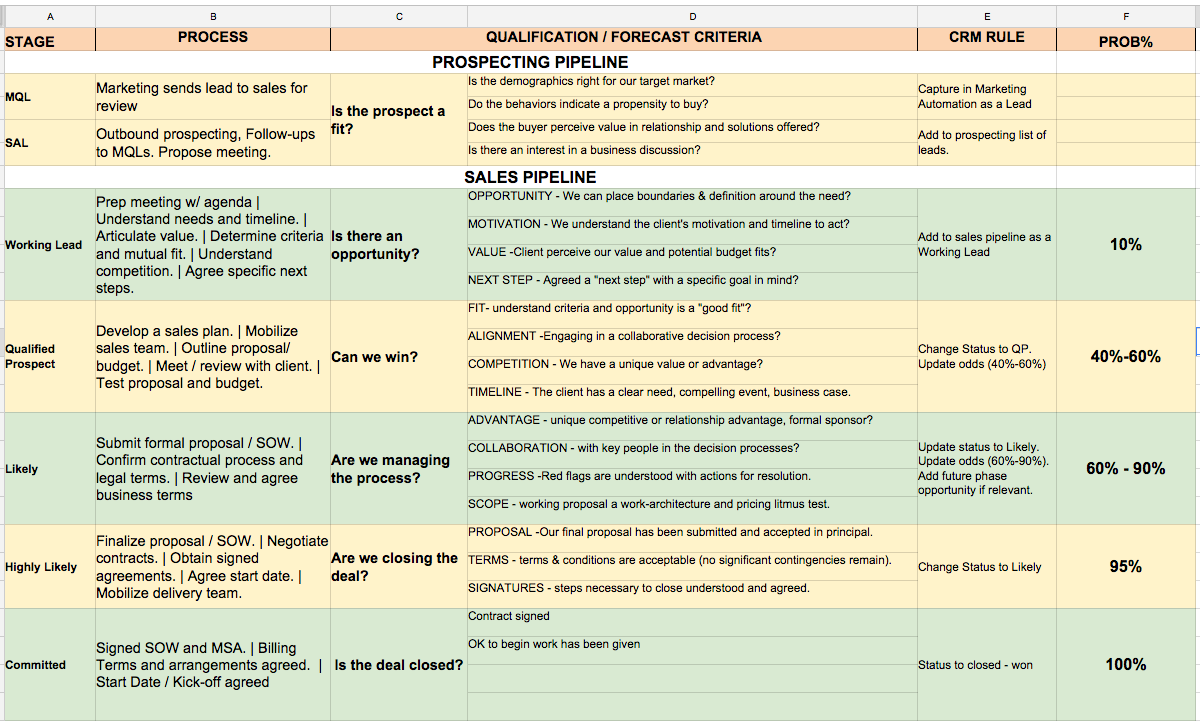A 5 Stage Sales Pipeline Management Model
Effective sales pipeline management is vital to your business. Align your teams around a ‘lingua franca’ to better manage deal qualification, forecasting and the sales process.
We know the B2B sales pipeline is changing. Inbound marketing and emerging marketplaces (like 99designs, Thumbtack and BlurGroup among others) manage elements of prospecting and the lead generation cycle outside of direct sales. Marketing plays a bigger role to drive inbound leads into the sales pipeline and marketplaces can replace some elements of sales outbound prospecting.
In complex or considered sales, the professional management of the sales process from working lead to committed remains vital. It is important to get the sales team on the same page and using the same sales process. Quite often, we see companies that are not using a common language for the sales pipeline. Forecasting is much more difficult when we are unclear about the status of each deal and the stage in the process. Firms often over-invest in some deals and under-invest in others while colleagues who support the sales effort become frustrated when time is wasted.
A 5-Stage Sales and Pipeline Management Model
The image below depicts the model we use. It has evolved out of my experiences from different companies. Revenue Architects settled on a model that is flexible and easy to use and remember. I used roughly similar stages at IBM, but adopted these five stages at Viant, and evolved it further at PA Consulting. Despite looking at a range of other tools and models, I have found that this one works the best:
- Working Lead – a stage/ status where the sales team is still determining basic fit and qualification.
- Qualified Prospect – a stage/ status where the sales effort is fully underway and the client meets important qualification criteria.
- Likely – a stage/ status where buying indications are clear and the steps needed to close the deal are being orchestrated.
- Highly Likely – a stage/ status where the final legal terms are being agreed and signature is pending.
- Committed – a stage/ status where the deal is closed and delivery can begin.
4 Factors to Consider when designing your pipeline process.
1. Tie stages to qualification instead of activity.
Quite often, pipeline stages within the CRM are tied to the sales steps or activities like “proposal stage” instead of being connected to the actual qualification. By tying the two together, the organization begins to understand the nature and importance of the deal in the overall pipeline and qualification process. For example, it may be that we are at the “proposal stage” too early because the deal is not qualified. Apply the ‘status’ to each deal and make the ‘steps’ in the process secondary.
2. Fix qualification percentages to stages.
While you want to build in some flexibility on forecasting percentages within stages – particularly in the middle of the sales cycle – a good way to reinforce the lingua franca of the organization is to firm up qualification percentages. Once you have done that, you can assign fixed qualification ranges at each stage of the sale. This not only helps with forecasting, but also helps everyone involved in the sale understand where we are in the process and the likelihood of a close. By applying criteria and rules, reps can work to improve the understanding of the deal and the potential for a sale, as well as guide the development of a unique value proposition.
3. Connect the sales process and qualifying criteria to the operating model.
Another way to reinforce the model is to agree a common qualification model (like our FACT, BANT, TAS, SCOTSMAN, etc.) and build this into the operating model. We use a more collaborative approach called FACT to avoid what can be an adversarial buyer-seller relationship during the qualification process. The model you select should be integrated in your CRM system so it’s accessible to all members of the organization. Rules need to be defined at each stage to direct the sales teams on what approvals are required, what assets are produced and how the CRM should be used.
4. Tie management to the operating model.
Ensure that your sales management teams are themselves experts in the model and the qualification criteria. Sales stages are reinforced it at every step of the process. In addition to asking good questions about each deal, sales managers can reinforce the forecasting rules in the CRM system and be more informed about the accuracy of the pipeline forecast. In addition to sales management, the marketing and business organization will all share a common language for the sales pipeline.
If you would like to learn more about this model or considerations in implementing a sales pipeline management process in your organization, please contact me: John Stone.










Leave a Reply
Want to join the discussion?Feel free to contribute!